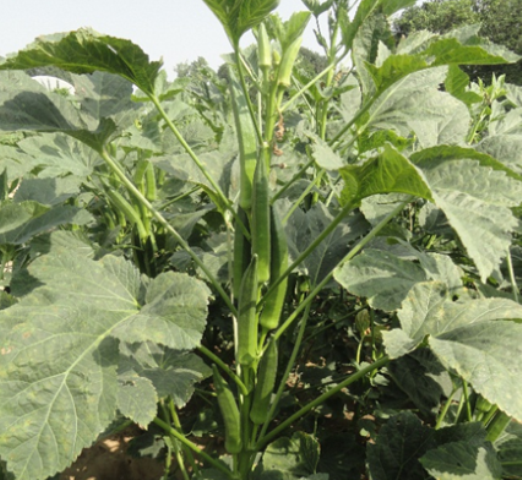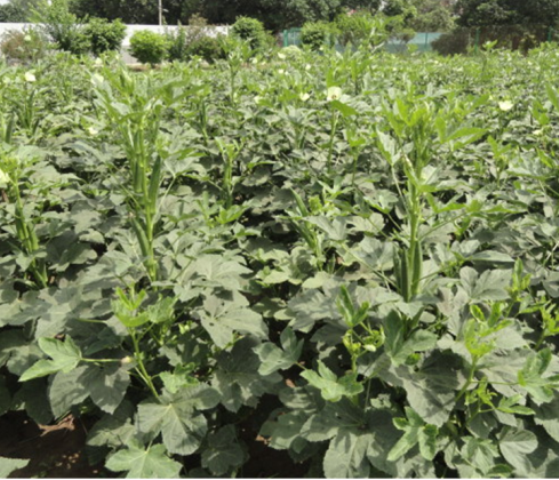
Okra (Abelmoschusesculentus L. (Moench) 2n=2x=130) belongs to Malvaceae family. It is an important fruit vegetable grown throughout the tropics and warmer parts of the temperate zone. The cultivated species, Abelmoschusesculentusis known by various names in the world, such as lady’s finger and okra in English, bhindi in Hindi, tindisha and gandhamula in Sanskrit.
India is leading producer of okra in the world and it contributes more than 72% of total okra production in the world. In India okra occupies around 0.514 million hectare area and its production is around 6.126 million tonnes. Tender pods were earlier developed against YVMV resistance, are no more fully resistant to YVMV disease, therefore, identification of new sources of resistance is the need of hour.
Keeping the above facts in mind, Pusa Bhindi-5 has been developed to enhance the production and productivity of okra during kharif season in North India. Keeping the above in view, Pusa Bhindi-5 (DOV-66) a high yielding variety of okra with superior fruit quality and Bhendi Yellow Vein Mosaic Virus resistance for Kharif season for northern plains has been developed by ICAR-Indian Agricultural Research Institute, Pusa, New delhi and notified by Central Variety Release Committee, Govt. of India.

Salient characteristics of Pusa Bhindi-5:
-
It is a high yielding (18.0 t/ha) variety of okra and resistant to Bhendi Yellow Vein Mosaic Virus.
-
Plants are straight having 2-3 branches with completely dark green stem and petioles. Leaves are moderately lobed.
-
Pods are attractive dark green colour with 5 ridges, smooth surface, medium in length (10-12 cm).
-
Recommended for growing in kharif season (15 June to 15 July sowing) as well as in spring summer (15 February to 15 March sowing) season under north Indian condition.
Crop Production:
Climate
It is a warm season vegetable crop and requires a long warm growing season. The seeds will not germinate properly below 18oC. It is susceptible to frost and will not thrive well when there is a continuous cold spell.
Soil
It can be grown in all kinds of soils, but sandy loam, friable andrich in organic contents is good for its cultivation.
Seed rate
12-15 kg/ha - During Spring-Summer Season.
8-10 kg/ha, During Rainy/Kharif Season.
Sowing
It can be grown throughout the year where frost and severe winters are absent. In plains and frost-free areas, the first sowing is done from second fortnight of February to March and the second during June-July. It is sown on flat beds, but in high rainfall or waterlogged areas, it should be sown on raised beds.
Spacing:
Row to row: 45 cm during spring summer and 60cm during kharif/rainy season
Plant to plant: 20 cm during spring-summer and 30 cm during kharif/rainy season.
Manure and fertilizers
Thirty tonnes of well rotten Farm Yard Manure, alongwith N: P: K @100:50:60 kg/ha should be applied. 1/3 dose of nitrogen and full amount of phosphorus and potash should be applied at last field preparation just before sowing. Remaining nitrogen (2/3rd nitrogen) should be applied in three equal split dosed at 30, 45 and 60 days after sowing.
Irrigation
The crop should be irrigated as per requirement during summer and whenever required in the rainy season. Always light irrigation should be given.
Inter-culture
Apply pendimethalin solution @ 3litre/ha in 500 litre of water immediately after sowing, when there is sufficient moisture in the soil. Manual weeding should be done as per need and earthing up in the rows should be done after weeding, especially during the rainy season.
Harvesting
Fruits are continuously harvested six to seven days after opening of flowers, when they are tender. The growth and bearing of the plant are adversely affected if the fruits are not harvested timely.
Average yield
120 q/ha during spring-summer season.
180 q/ha during kharif/rainy season.
Plant protection
Insect-pests
Jassid or leaf hopper
The insects are in greenish yellow in colour and the adults and nymphs suck the sap from the lower surface of leaves, causing curling of leaves and burning effects on the edges. The insects lay small whitish round eggs on the lower surface of leaves.
Control: alternate spraying of acetamiprid @ 0.03-0.05% solution and spiromesifen @ 0.3- 0.5 ml/litre of water at 10 days interval.
Shoot and fruit borer
The larvae bore into the tender shoots and fruits, causing stunted growth of plants and fruits are rendered unfit for consumption.
Control:
Spray neem seed kernel extract (5%) or spraying of malathion @ 2 ml/litre at 10 days interval. Installation of pheromone trap @20 traps/ha. Apply spinosad @ 0.3-0.5 ml/litre water solution
Whitefly
The adults and nymphs suck the sap from the lower surface of leaves and damage the crop by transmitting Bhendi yellow vein mosaic virus disease.
Control:
Sowing of 3 rows of maize/bajara on all borders of field around 45 days advance. Place yellow sticky traps in the field @20 traps /ha.
Alternate spraying of [email protected] % solution or flonicamid @ 0.3-0.5 g/litre water at 10 days interval.
Red spider mite
The insects are very tiny and light reddish-yellow in colour and make net on lower surface of leaves. Adults suck the sap from the lower surface of leaves, causing yellowing of leaves and burning effects on the leaves by causing necrotic effect.
Control:
Spraydicofol @ 2ml/litre or spiromesifen @ 5ml/10 litre of water at 10 days interval.
Bhendi Yellow Vein Mosaic Virus
This variety is resistant to vein clearing virus disease. In severe cases, in fag end of the crop it may come in few plants. It is transmitted by whitefly.
Control:
Control whitefly same as mentioned above.
Authors;
R.K. Yadav, B. S. Tomar and Sumanlata
Division of Vegetable Science, ICAR-IARI, New Delhi-12
*Email of corresponding author: [email protected]
















